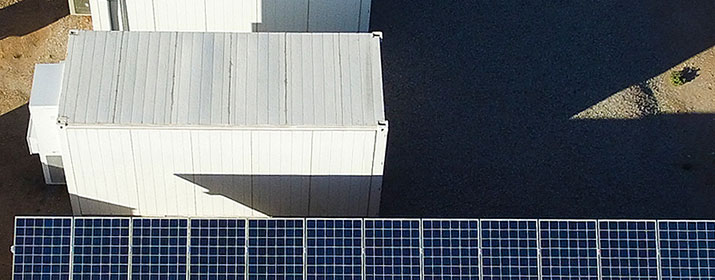
We’re building new energy storage systems that will allow us to deliver more power from the sun, even later in the day when solar panels are producing less of it.
TEP expects to expand our energy storage capacity from about 50 megawatts (MW) today to more than 1,300 MW by 2038. These resources will play a key role as TEP works toward net zero greenhouse gas emissions by 2050.
One of the biggest benefits provided by battery energy storage systems is their ability to store solar energy generated at midday when it’s abundant and typically costs less than power during peak usage periods, said Neil Saunders, Principal Renewable Development Manager.
“Essentially, you’re moving power you created during the day to the evening peak by using a battery. The abundance of solar in the midday when customers’ energy needs are relatively low can lead to curtailments of solar production,” Saunders said. “Battery systems can maximize solar production by storing clean energy for our afternoon and evening peaks.”
Construction is now underway on TEP’s 200 MW Roadrunner Reserve, our newest and largest battery energy storage system. The project is designed to store 800 megawatt-hours (MWh) of energy, enough to serve approximately 42,000 homes for four hours when deploying at full capacity. The system will be among the largest in Arizona when it’s up and running the summer of 2025.
“For TEP, the Roadrunner Reserve system is really a game changer in terms of solar shifting,” said Lauren Briggs, Director of Resource Procurement & Planning. “When it comes online, we’ll be storing a lot more energy produced in the morning, then delivering that energy during times of peak demand when customers’ energy needs are greatest.”
Battery systems provide other important benefits, Briggs said.
TEP has more than 447,000 customers with energy needs that change from moment to moment throughout the day. We must respond instantly, delivering enough energy to meet those needs. This makes wind and solar resources more challenging because their production varies throughout the day, sometimes in unpredictable ways.
“Batteries can release energy extremely quickly, much more quickly than traditional generation. If a cloud passes over and the sun goes away, the energy produced by solar panels will drop. Batteries can react very quickly to fill in the gaps,” Briggs said.
Battery energy storage systems are considered “inverter-based resources,” a class of energy resources including solar panels and wind turbines that rely on devices called inverters to convert electricity from direct current to alternating current before being delivered to the grid.
Battery systems will also play a key role as TEP works toward net zero direct greenhouse gas emissions by 2050. The goal is aspirational, reflecting confidence that advancements in long-duration storage and other types of non-carbon emitting technologies will emerge as cost-effective options. While solar plus storage is currently more expensive than natural gas resources, cost projections indicate these costs are expected to decrease over the next 10-12 years.






